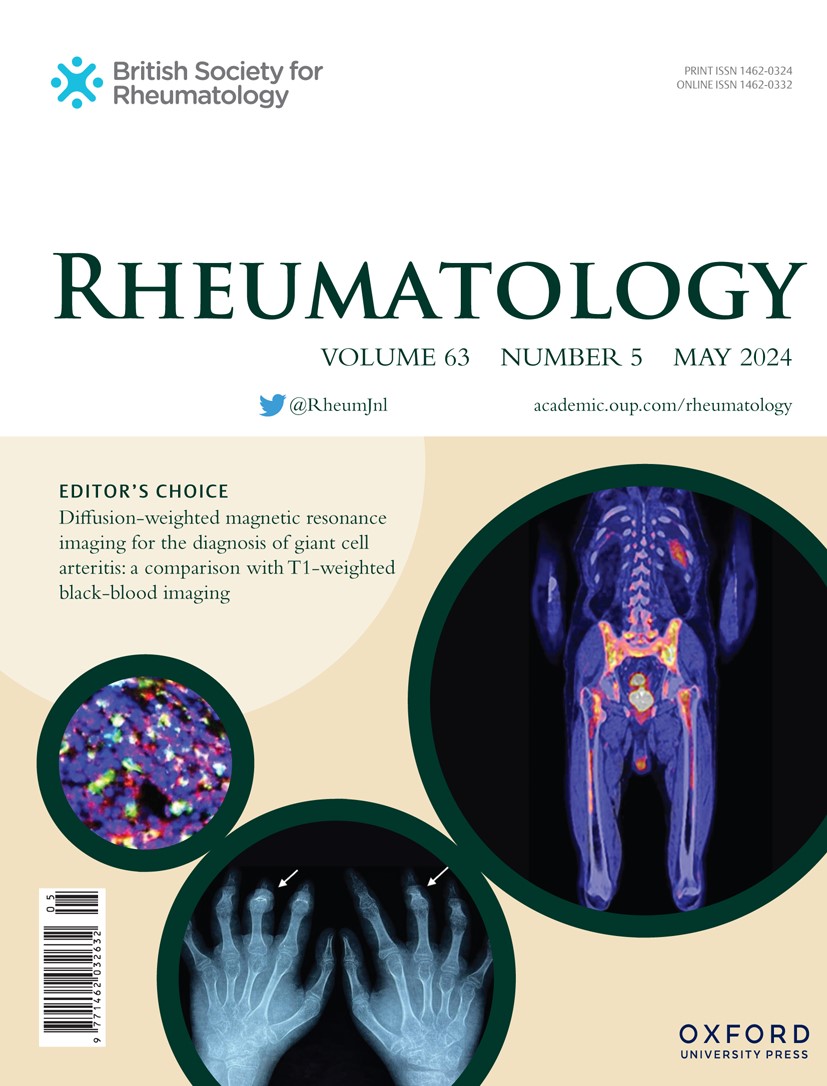E095 Implication of IL23/IL17 axis in ankylosing spondylitis
IF 4.7
2区 医学
Q1 RHEUMATOLOGY
引用次数: 0
Abstract
Background/Aims In recent years, significant attention has been directed towards the role of cytokines in the development and progression of ankylosing spondylitis (AS), particularly the pivotal involvement of interleukin-17 (IL-17) and interleukin-23 (IL-23) in the dysregulation of immune responses observed in AS, holding promise for the development of targeted therapies. Given their growing therapeutic interest, the purpose of this study was to search for evidence supporting a prognostic interest in interleukins 17 and 23. Methods We collected 41 patients with AS in our department. We measured their levels of IL-17 and IL-23 and compared them to the levels of a paired control group. We calculated the Ankylosing Spondylitis Disease Activity Score (ASDAS-CRP) and Bath Ankylosing Spondylitis Disease Activity Index (BASDAI) scores in these patients, and we documented their extra-articular symptoms. We sought relationships among these data using SPSS 25.0. Results IL-17 and IL-23 levels were significantly higher in patients with AS (G1) versus the control group (G2). For IL-17: (G1=91,26±12,58 vs G2=1,14±0.27 pg/mL, p < 0.05). For IL-23: (G1=22,73±4,36 vs G2=2,6±1.27 pg/mL, p < 0.05). There was no observed correlation between BASDAI and ASDAS-CRP scores, and IL-17 and IL-23 levels. Similarly, no correlation was found between the duration of progression of AS and the levels of these cytokines. No link was found between IL-17 and IL-23 and markers of inflammation (ESR, CRP). There was no significant difference in the levels of IL-17 and IL-23 when comparing patients with uveitis (G1) and those without uveitis (G2). For IL-17: (G1=110,73±41,97 vs G2=87,92±13,1 pg/mL, p > 0.05). This was also the case for psoriasis, renal, cardiac, and pulmonary manifestations. Also, no correlation was found between IL17 and IL23 levels and the number of extra-articular manifestations. Conclusion Further research may be needed to explore these associations more comprehensively and better understand the role of interleukin-17 (IL-17) and interleukin-23 (IL-23) in AS and their prognostic significance. Disclosure M. Slouma: None. N. Makhlouf: None. M. Dhifallah: None. L. Kharrat: None. A. Tezeghdenti: None. I. Gharsallah: None.IL23/IL17轴在强直性脊柱炎中的意义
背景/目的近年来,细胞因子在强直性脊柱炎(AS)发生和发展中的作用受到了极大的关注,特别是白细胞介素-17 (IL-17)和白细胞介素-23 (IL-23)在AS中观察到的免疫反应失调中的关键作用,为靶向治疗的发展带来了希望。鉴于白细胞介素17和白细胞介素23在治疗中的作用越来越大,本研究的目的是寻找支持白细胞介素17和白细胞介素23在预后中的作用的证据。方法收集本科41例AS患者。我们测量了他们的IL-17和IL-23水平,并将其与配对对照组的水平进行了比较。我们计算了这些患者的强直性脊柱炎疾病活动评分(ASDAS-CRP)和巴斯强直性脊柱炎疾病活动指数(BASDAI)评分,并记录了他们的关节外症状。我们使用SPSS 25.0来寻找这些数据之间的关系。结果AS患者(G1) IL-17和IL-23水平明显高于对照组(G2)。IL-17: G1=91,26±12,58 vs G2=1,14±0.27 pg/mL, p <;0.05)。IL-23: G1=22,73±4,36 vs G2=2,6±1.27 pg/mL, p <;0.05)。BASDAI和ASDAS-CRP评分与IL-17和IL-23水平之间没有观察到相关性。同样,在AS进展的持续时间和这些细胞因子的水平之间没有发现相关性。未发现IL-17和IL-23与炎症标志物(ESR, CRP)之间的联系。葡萄膜炎患者(G1)与无葡萄膜炎患者(G2) IL-17、IL-23水平差异无统计学意义。IL-17: G1=110,73±41,97 vs G2=87,92±13,1 pg/mL, p >;0.05)。牛皮癣、肾脏、心脏和肺部表现也是如此。此外,il - 17和il - 23水平与关节外表现的数量没有相关性。结论白细胞介素-17 (IL-17)和白细胞介素-23 (IL-23)在AS中的作用及其预后意义有待进一步研究。斯洛马:没有。N. Makhlouf:没有。M. Dhifallah:没有。L.哈拉特:没有。A. Tezeghdenti:没有。I. Gharsallah:没有。
本文章由计算机程序翻译,如有差异,请以英文原文为准。
求助全文
约1分钟内获得全文
求助全文
来源期刊

Rheumatology
医学-风湿病学
CiteScore
9.40
自引率
7.30%
发文量
1091
审稿时长
2 months
期刊介绍:
Rheumatology strives to support research and discovery by publishing the highest quality original scientific papers with a focus on basic, clinical and translational research. The journal’s subject areas cover a wide range of paediatric and adult rheumatological conditions from an international perspective. It is an official journal of the British Society for Rheumatology, published by Oxford University Press.
Rheumatology publishes original articles, reviews, editorials, guidelines, concise reports, meta-analyses, original case reports, clinical vignettes, letters and matters arising from published material. The journal takes pride in serving the global rheumatology community, with a focus on high societal impact in the form of podcasts, videos and extended social media presence, and utilizing metrics such as Altmetric. Keep up to date by following the journal on Twitter @RheumJnl.
 求助内容:
求助内容: 应助结果提醒方式:
应助结果提醒方式:


